Best Competitor Monitoring Tools You Need to Stay Ahead
Table of contents
Are you looking for competitor monitoring tools? Fantastic! I have compiled a list of helpful tools that can assist you in monitoring your competitors across various areas, including SEO, social media, content, email marketing, and more.
- Competitor monitoring tools give you instant access to competitor data, from keyword rankings to content performance, helping you track multiple competitors in one place.
- They provide competitive intelligence and actionable insights into competitor websites, social media presence, PPC campaigns, and keyword gaps.
- Conducting competitive analysis with the right software solutions uncovers market trends, audience demographics, and competitor insights, which can be used to refine your own content strategy.
- Tools like Brand24, Ahrefs Site Explorer, and SimilarWeb deliver detailed reports on competitor domains, keyword research, search traffic, and social media monitoring.
In this article, we’ll review the top marketing tools you need to conduct competitor analysis, transform raw data into actionable competitive insights, and stay ahead in your market.
Along the way, I’ll show you how a media monitoring tool can help you leverage business intelligence and social media intelligence to better understand your competitors and uncover business growth opportunities.
Let’s dive in!
Top competitor monitoring tools:
01 Brand24 for mentions monitoring
Brand24 is a media monitoring tool that helps you monitor your competitors on social media, websites, forums, blogs, podcasts, newsletters, review sites, and other sources.
With this advanced brand monitoring tool, you can track all mentions of your competitors across the Internet. It provides real-time data on competitor mentions, which helps you stay informed about their campaigns, activities, and customer interactions.
What’s very helpful is that the tool offers a comparison feature.
It allows you to benchmark your brand’s online performance against competitors.
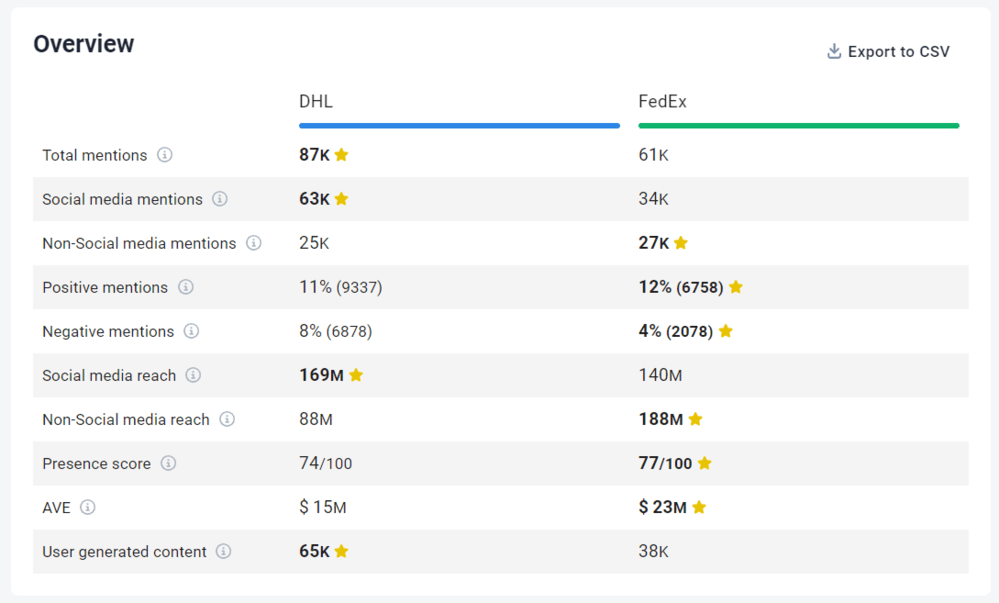
This tool offers many AI features, like Brand Assistant.
It works like ChatGPT; you can ask everything about your competition. It shows exact information, saving you time!
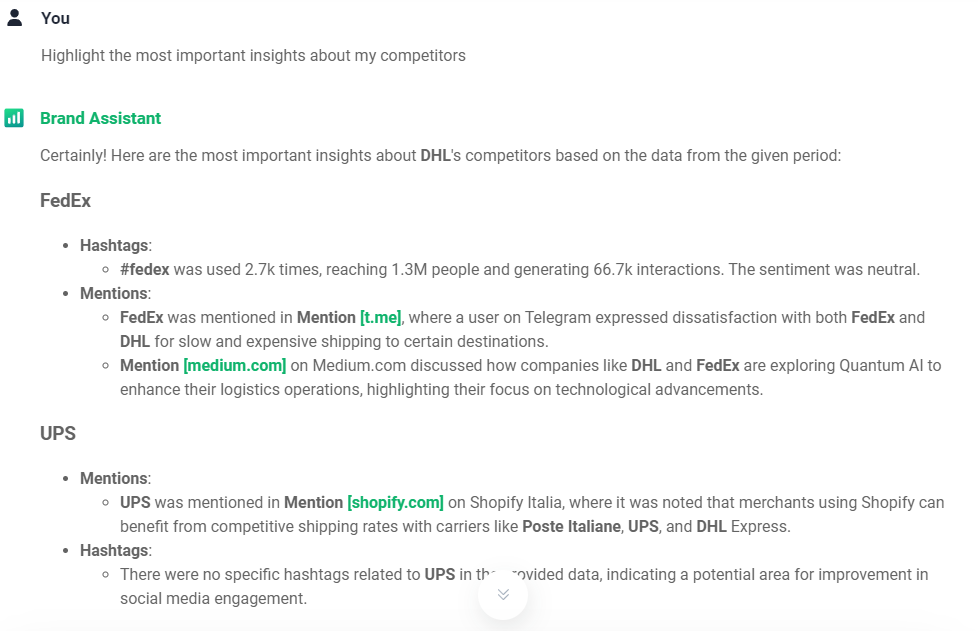
Key features:
- Media monitoring – It tracks mentions from many sources in real-time. It lets you analyze metrics such as reach, engagement, Online Reputation Score, Online Presence Score, Share of Voice, and AVE to evaluate your brand’s position relative to competitors.
- Anomaly Detector – it keeps an eye on your competitors, shows you any unusual spikes in mentions and reach, and explains what caused that.
- Sentiment analysis – it analyzes the sentiment associated with competitor mentions, determining whether the sentiment is positive, negative, or neutral.
- Influencer identification – you can identify influential individuals engaging with or mentioning your competitors. This allows you to assess the impact of these influencers and potentially collaborate with them to amplify your own brand presence.
- Topic analysis – it identifies and examines topics associated with brands. This helps you keep track of trending topics, who is talking about them online, and where most of the mentions are coming from.
- Detailed Competitive Analysis Report – generate comprehensive insights into competitor activity. Reports are available in multiple formats, including QuickShare links, AI-powered summaries, PDF, Excel, and more, making it easy to share with your team or stakeholders.
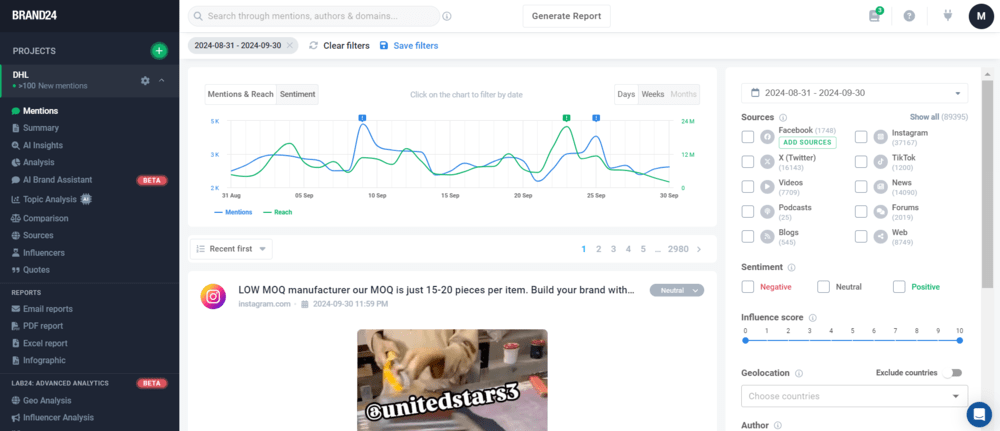
Monitor your competitors on social media, forums, blogs, newsletters, and podcasts!
02 SimilarWeb for website traffic analytics
SimilarWeb is one of the powerful competitor monitoring tools that provides valuable insights.
With SimilarWeb, you can evaluate the traffic and engagement metrics of your competitors’ websites. It gives you an idea of their total visits, pageviews, bounce rates, and average visit duration.
By analyzing this data, you can determine how popular and engaging your competitors’ websites are compared to yours.
The tool provides information about the sources driving traffic to your competitors’ websites. You can identify which channels, such as search engines, social media, referrals, or direct traffic, generate the most visitors.
Key features:
- Website traffic analysis
- Audience demographics
- Competitor benchmarking
- Competitor detecting
- Audience interests
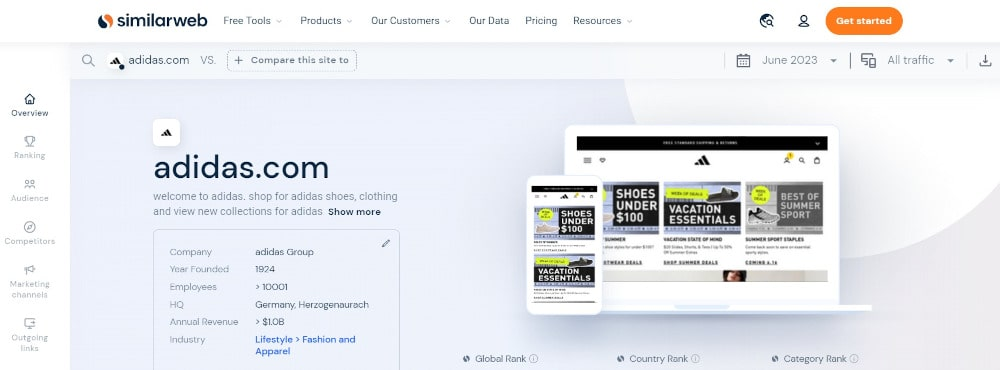
03 Google Trends for trend tracking
Google Trends is a free tool that can provide valuable competitor insights and their online presence.
With Google Trends, you can compare the search interest for various keywords or topics, such as your competitors’ brand names.
By analyzing the search interest over time, you can determine your competitors’ brands’ market trends and popularity.
What’s interesting is that Google Trends provides valuable information about the regions where search interest for specific keywords or brands is highest. This data helps you understand the regional markets where your competitors are gaining traction or facing challenges.
Moreover, Google Trends also offers demographic insights about the age and gender distribution of search interest, which can help you better understand your competitors’ target audience.
Key features:
- Search interest comparison
- Regional and demographic insights
- Rising queries and topics
- Related topics and queries
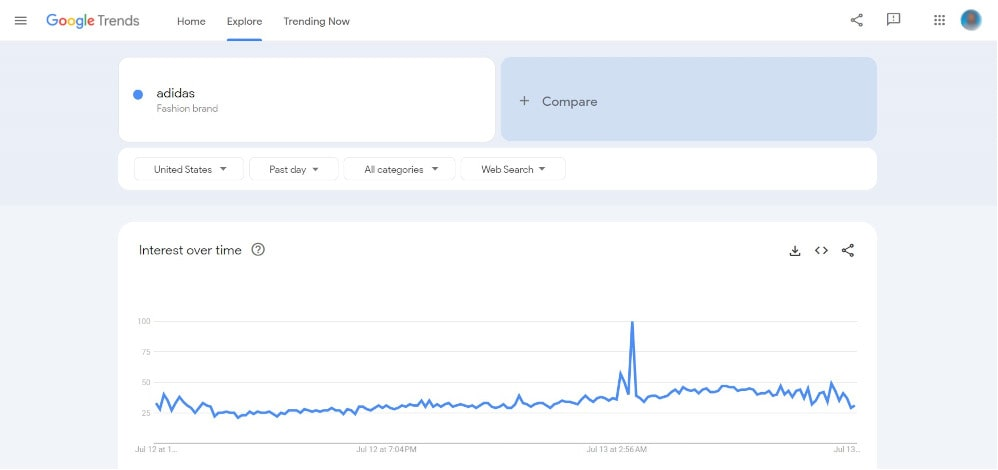
04 Ahrefs for SEO analysis
Ahrefs is a well-known SEO analysis tool that also provides competitor analysis features.
With Ahrefs, you can easily identify your competitors’ best-performing content, keywords, and organic search strategies. Additionally, this tool provides actionable insights into your competitors’ paid search campaigns.
With Ahrefs, you can conduct comprehensive competitor keyword research. It allows you to uncover the organic keywords your competitors rank for, their search volumes, and estimated traffic.
This information can help you gain valuable insights into their keyword strategies, identify potential growth areas, and optimize your SEO efforts.
Ahrefs provides various competitive analysis features that allow you to compare your website’s performance. You can analyze their domain authority, backlink profiles, and organic traffic to assess your relative market position and identify areas for improvement.
Key features:
- SEO competitor analysis
- Content gap analysis
- Backlink analysis
- Keyword research
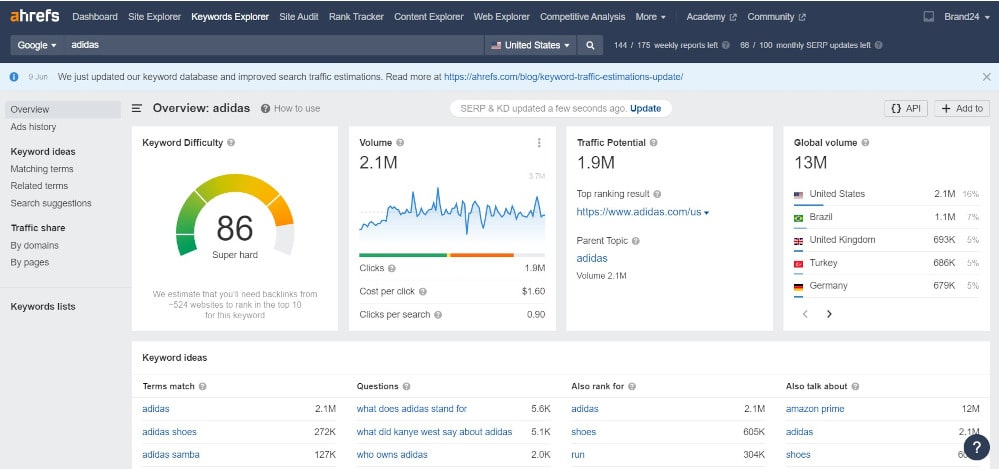
Try the best competitor monitoring tool!
05 Rival IQ for social media comparison
Rival IQ is a competitive analysis tool specializing in social media marketing.
With Rival IQ, you can monitor your competitors’ activities across multiple social media platforms. You can track their follower growth, engagement metrics, posting frequency, and content performance.
This enables you to gain insights into their social media marketing strategy, identify the types of content that perform well, and measure your own performance against theirs.
Did you know that with Rival IQ, you can make simple social media comparisons without spending any money?
Simply select a competitor and create an email report that will identify their top-performing posts, activity level, engagement, and audience information.
Key features:
- Social media benchmarking
- Social media audit
- Social media posts analysis
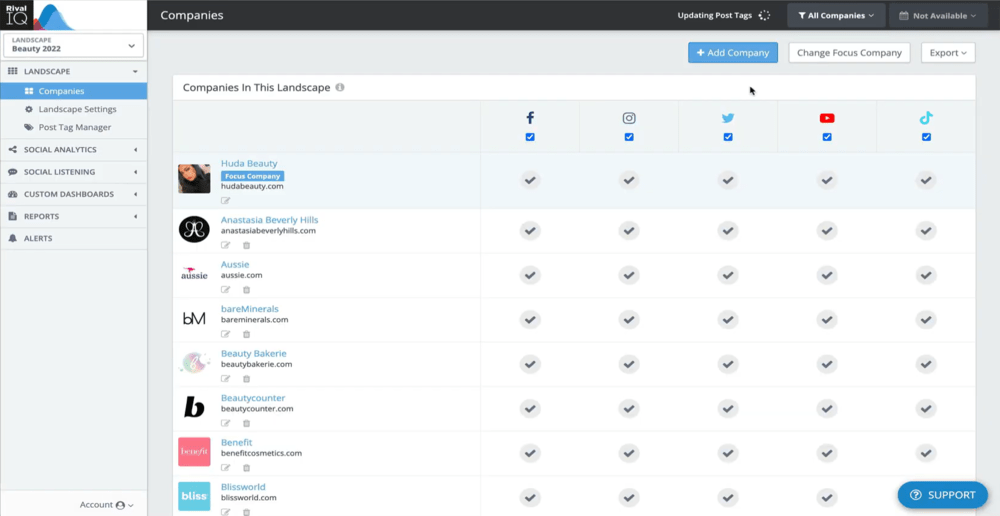
06 vidIQ for tracking YouTube competitors
vidIQ is a competitor media monitoring software specifically designed to help monitor and optimize YouTube channels and videos.
With vidIQ, you can get a detailed analysis of your competitors’ YouTube channels. You can check out their top-performing and trending videos, view counts, subscriber growth, and channel performance.
This information will help you understand their content strategy, identify popular video topics, and evaluate their audience engagement.
vidIQ provides competitor keyword research tools tailored for YouTube. You can discover trending and relevant keywords and assess their search volume, competition, and ranking difficulty.
Key features:
- Competitor analysis of channels
- Trending video insights
- Subscriber analytics
- Keyword research
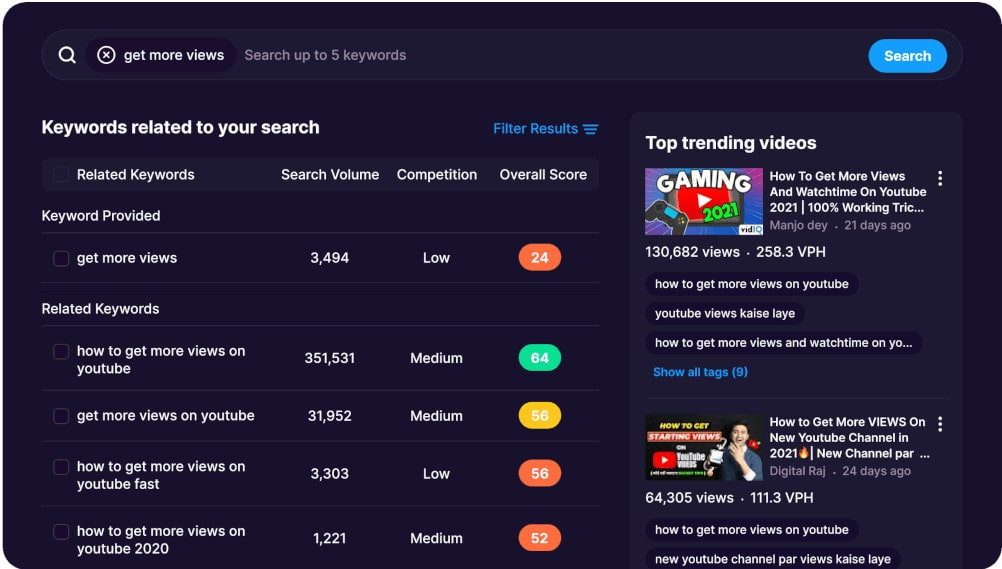
07 BuzzSumo for tracking competitors’ content
BuzzSumo is an efficient tool for researching and planning content marketing strategies. It can provide a wealth of information about what’s working in your industry or niche, including information about your competitors.
You can use BuzzSumo to see which pieces of content from your competitors get the most shares and engagement on social media. This allows you to understand the types of content that resonate with your target audience, and you can produce similar (but better) content.
BuzzSumo allows you to identify key influencers in your industry who are sharing your competitors’ content. This provides potential targets for influencer marketing and identifies potential partners who can help promote your content and reach new customers.
Key features:
- Content tracking
- Competitive analysis of content
- Key influencers identification
- Competitors’ content performance
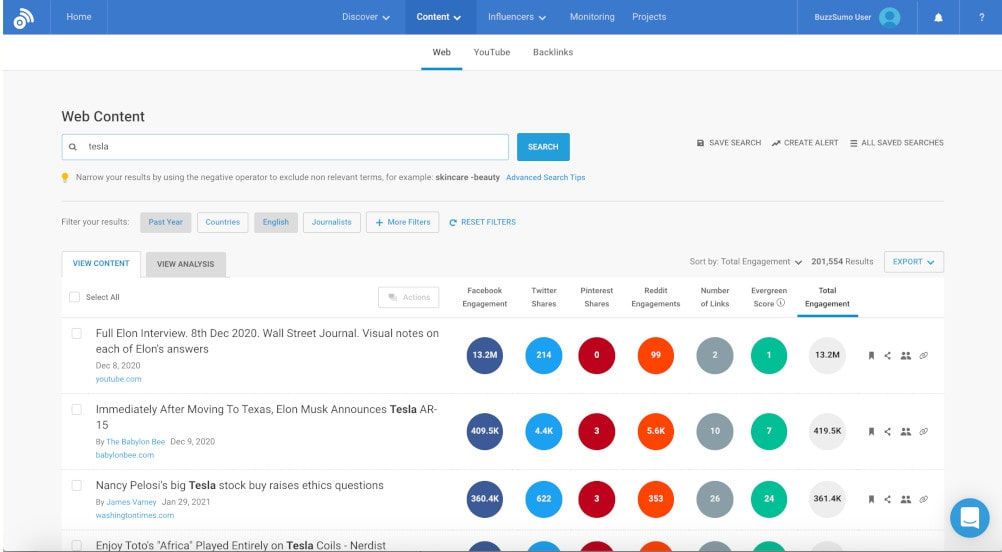
Monitor what your competitors are doing!
08 Visualping for website monitoring
Visualping is primarily used to monitor changes on your competitors websites. It can automatically track modifications to their web pages and notify you when changes are detected.
With Visualping, you can monitor and track changes to your competitors’ websites. This could include updates to product offerings, pricing changes, promotional offers, updates to their “About Us” or “Team” pages, and more.
The tool will help you monitor your competitors’ pricing strategies. You will be notified if they make any changes to their pricing.
Key features:
- Website changes monitoring
- Product pricing tracking
- Search Engine Optimization changes
- Content updates
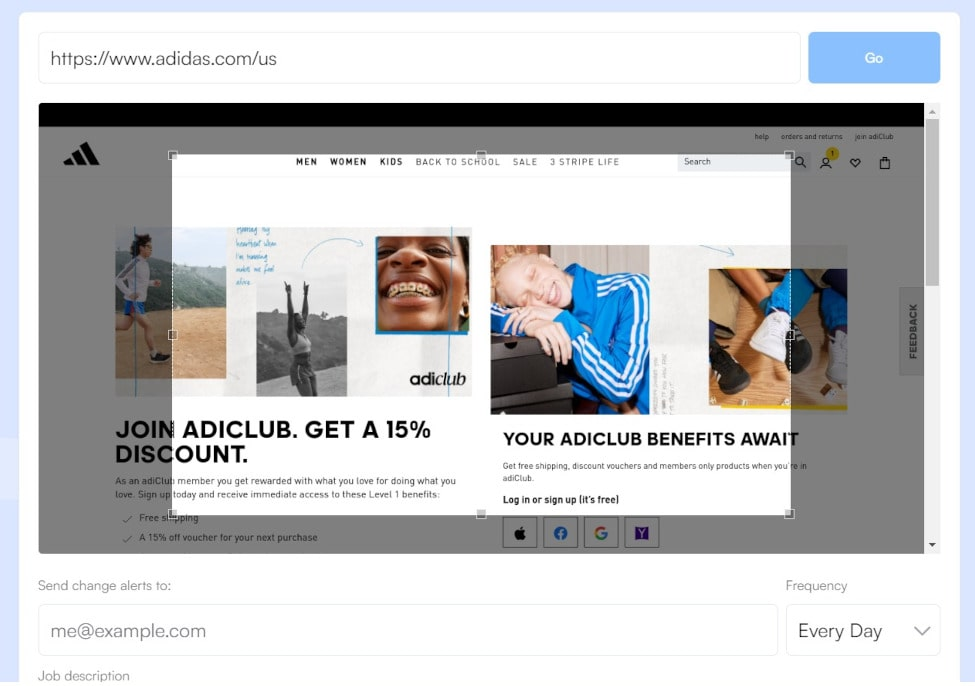
09 Wide Narrow for competitive advantage
Wide Narrow is a competitive intelligence tool that helps businesses monitor and analyze their competitors’ activities. It offers various features that can make online monitoring more effective and efficient.
The tool can pull data from various sources. This means you can track your competitors’ activities across multiple platforms in one place.
The tool helps sift through large amounts of data to find the most relevant and valuable information. It uses a combination of AI and machine learning to reduce noise and ensure you’re only getting the insights you need.
Wide Narrow is a tool that facilitates team collaboration. You can also configure alerts to inform you about important updates or changes.
Key features:
- Streamlined data collection
- Intelligent filtering
- Detailed reports
- Integrations
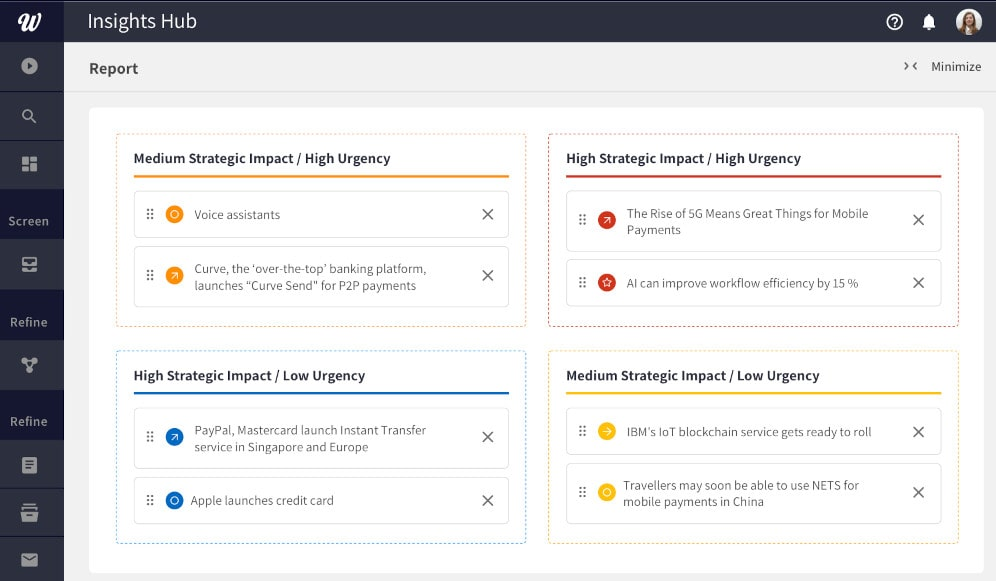
10 Wappalyzer for technology detecting
Wappalyzer is a tool for uncovering the technologies used on websites. It detects content management systems, e-commerce platforms, web servers, JavaScript frameworks, analytics tools, and more.
It’s always a great idea to closely examine what your competitors are up to. By checking out the technologies, platforms, and tools they are using, you might find some really helpful insights into their strategies.
Keep an eye on their technology stack. Try to understand why they’ve chosen them. You might even discover a new tool or platform to supercharge your business.
What’s interesting is that Wappalyzer can identify third-party tools like customer support chat systems, appointment scheduling widgets, and more. This can give you insights into your competitors’ user experiences.
Key features:
- Technology stack analysis
- Security analysis
- Budget & resources estimation
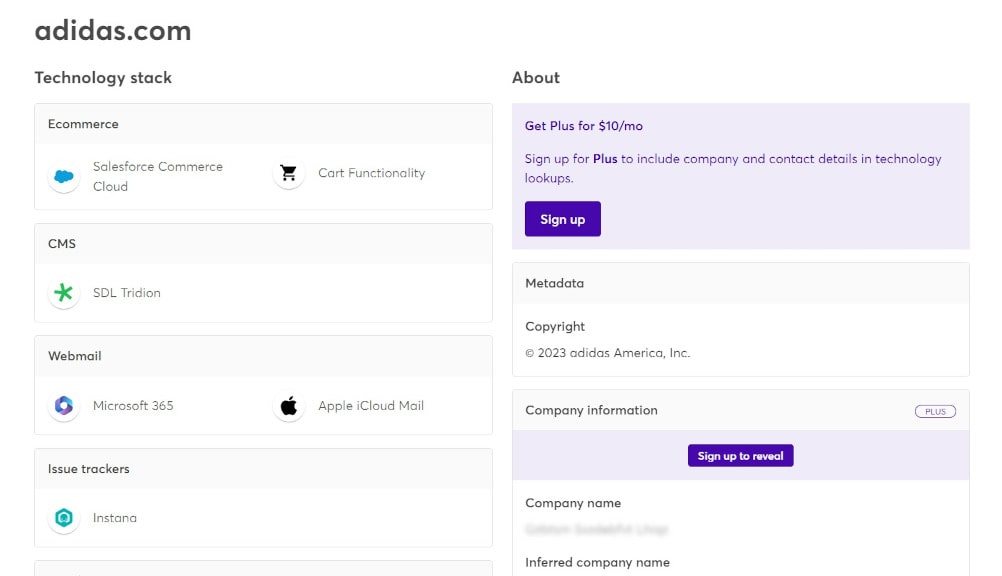
11 SparkToro for audience insights
SparkToro is a competitor research and audience intelligence tool. It will help you understand your competitor’s audience and how to reach them online.
SparkToro can help you understand where your competitor’s audience is engaging online. This includes which websites they visit, the social media accounts they follow, the podcasts they listen to, the videos they watch, and more.
SparkToro identifies the keywords and phrases used by your competitors’ audience in their content. This can assist you in comprehending their messaging and positioning.
Key features:
- Audience research
- Keywords discovery
- Influencer identification
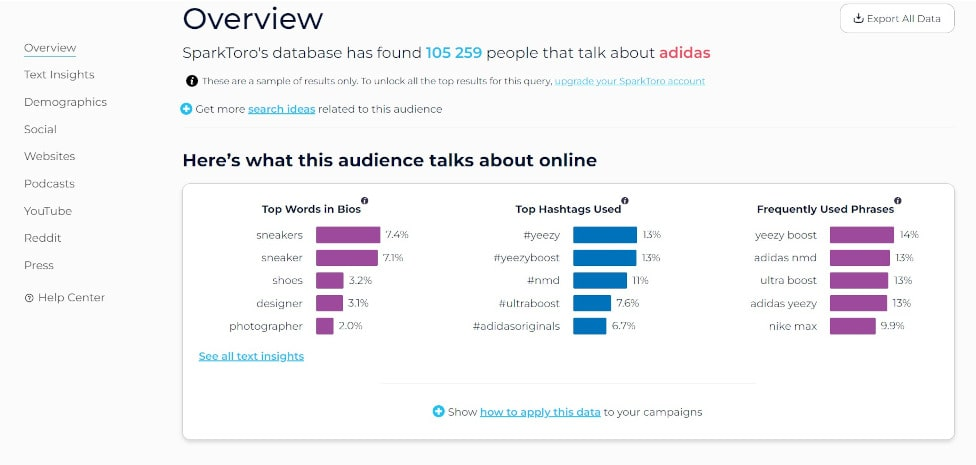
12 Boardfy for price monitoring
Boardfy is a pricing intelligence tool primarily used by e-commerce businesses to monitor competitor pricing. It automatically tracks price changes and promotions on your competitor’s websites and various marketplaces.
Boardfy tracks the prices of your competitors’ products across various platforms, such as Amazon, Google Shopping, eBay, etc.
The tool can automatically adjust your prices based on your pricing strategy and competitors’ charges. It allows you to set up pricing rules and implement them in real-time.
Also, Boardfy can send you alerts whenever a competitor puts a product on sale or runs a promotional offer.
Key features:
- Price tracking
- Promotion alerts
- Dynamic pricing
- Marketplace monitoring
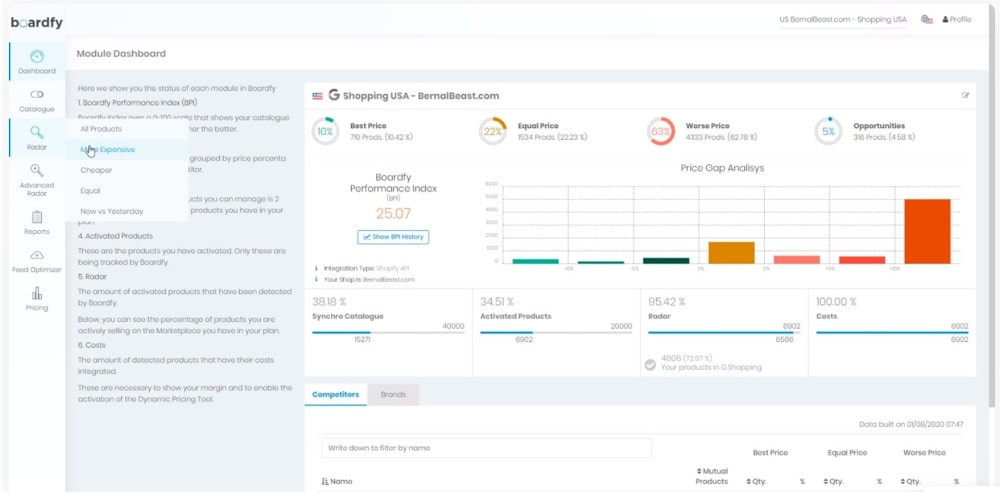
13 Owler for financial analysis
Owler is one of the competitive analysis tools that provides detailed insights about millions of companies, including information about their:
- Revenue
- Employees
- Funding
- Acquisitions
- Competitors
- Leadership
The tool detects similar companies that might be your potential rivals based on competitor data. Furthermore, Owler detects recent news, which can give insights into your competitors’ strategies and growth.
Also, Owler offers a “Competitive Graph” that visualizes your competitive landscape, helping you understand who your competitors are and how they relate to each another.
Key features:
- Company profiles analysis
- Competitive analysis
- Competitive Graph
- Company rankings
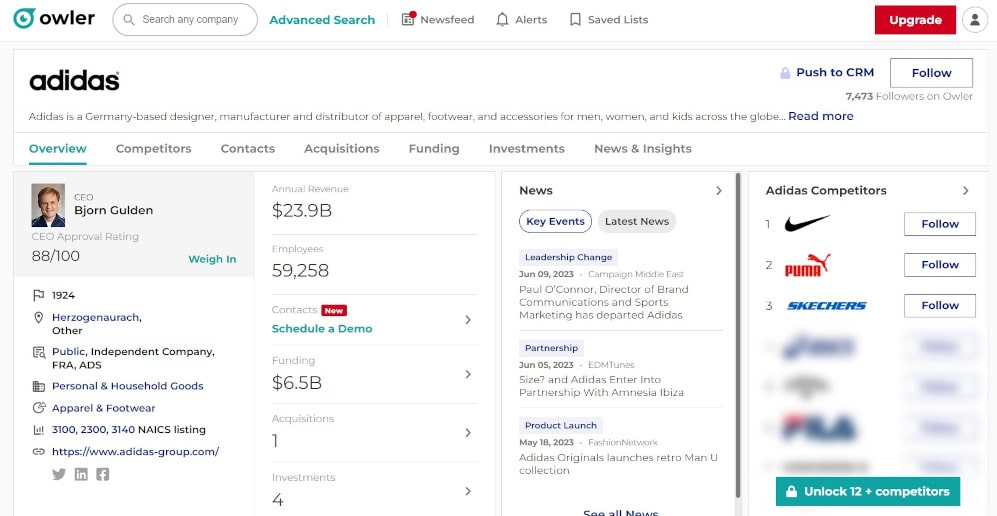
Start competitor monitoring! Detect their reach, sentiment, and mentions!
14 iSpionage for tracking ad campaigns
iSpionage monitors your competitors’ PPC and SEO strategies. The tool lets you see which keywords your competitors target in their PPC and SEO campaigns.
Thanks to iSpionage, you can see the exact ad copy your competitors use in their PPC campaigns. The tool estimates how well your competitors’ PPC campaigns are performing.
In addition to PPC, iSpionage provides information on your competitors’ organic search performance, helping you understand their SEO strategy.
Key features:
- PPC and SEO keyword research
- Ad copy analysis
- Campaigns performance
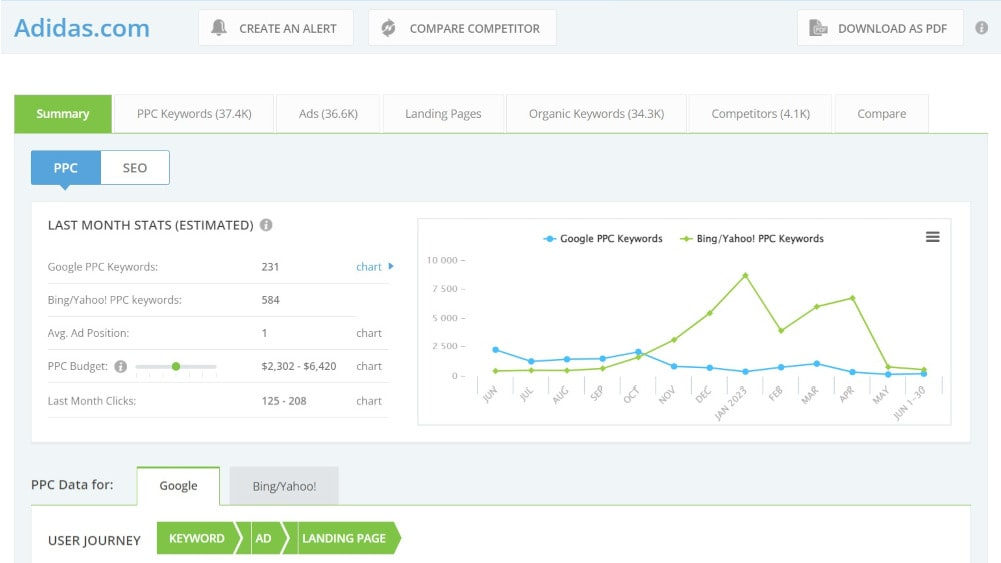
15 Owletter for email monitoring
Owletter is an email monitoring tool that can help you track your competitors’ email and newsletter strategies.
Owletter automatically captures and stores every email sent from the websites you want to monitor.
This tool analyzes how many emails your competitors have sent this year, the specific days they send the emails and the hours of the day when they send them.
It’s a perfect solution for those who want to get inspired to make better emails.
Key features:
- Email storage
- Email analysis
- Competitors spam reputation
- Trending topics in emails
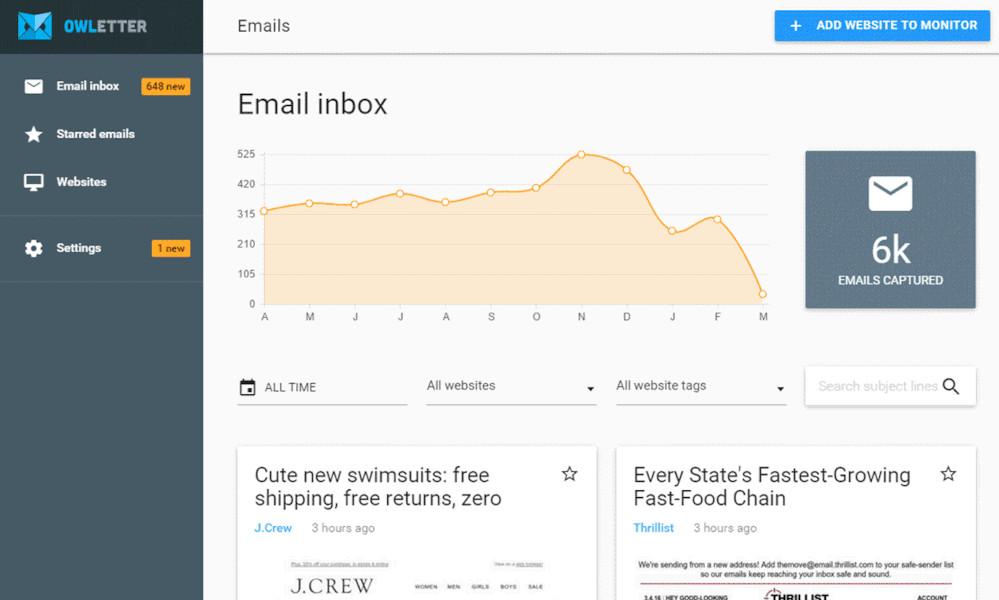
Why should you use competitor monitoring tools?
Well, exactly why?
With competitor monitoring tools, you can find out how to improve your business in various areas.
Here’s how each comprehensive competitor monitoring tool benefits you:
Brand24
Thanks to mentions monitoring, you will:
- Know what people are saying about your competitors and discover their pain points
- Identify topics associated with different brands
- Be able to compare your online performance with others
SimilarWeb
Thanks to analyzing website traffic, you will:
- Discover where competitors’ traffic comes from
- See how popular and engaging their websites are
Google Trends
Thanks to tracking trends, you will:
- See how big is search interests for your competitors and their products
- Identify geographical regions where competitors are gaining popularity
Ahrefs
Thanks to analyzing SEO, you will:
- Identify your competitors’ best-performing content
- Find content gaps to outperform competitors in organic search
- See SEO improvements and website changes
Rival IQ
Thanks to comparing social media profiles, you will:
- Gain insights into their social media marketing strategy
- Identify content that performs the best
vidIQ
Thanks to tracking your YouTube competitors, you will:
- Get a deep analysis of the YouTube strategies
- Identify topics that attract the largest audiences
BuzzSumo
Thanks to tracking content, you will:
- Discover the types that resonate with the audience
- Identify influencers who are associated with a certain type of content
Visualping
Thanks to website monitoring, you will:
- Stay informed on how competitors are updating their websites
- Be able to react quickly to any updates that affect your market
Wide Narrow
Thanks to competitive intelligence data, you will:
- Identify early market opportunities or potential threats
- Forecast future competitive trends
Wappalyzer
Thanks to detecting technologies used on websites, you will:
- Find new tools or platforms to supercharge your business
SparkToro
Thanks to the audience insights, you will:
- Uncover where your competitors’ audiences spend time online
- Be able to refine your marketing strategies
Boardfy
Thanks to price monitoring, you:
- Can adjust your pricing strategies based on competitors’ actions
- Ensure competitive pricing across various products or services
Owler
Thanks to financial analysis, you:
- Stay informed about major competitor activities
- Can compare your financial performance against industry leaders
iSpionage
Thanks to tracking ad campaigns, you will:
- See what is driving conversions for competitor PPC and SEO campaigns
Owletter
Thanks to email monitoring, you can:
- Improve your emails and newsletter
Summing it up, you see what your competitors are doing, notice what they are not providing to their customers, and then you can start providing it.
In addition, if your top competitors are successful, you will easily see what exactly causes it and then be able to implement it in your business.
Competitor Monitoring Example: iPhone vs Samsung
Now, using iPhone and Samsung, let’s see how you should monitor your competitors… with the help of the right tool, of course.
Mentions and reach
iPhone and Samsung’s volume of mentions and reach across multiple platforms over time are following:


As you can see, the iPhone is mentioned more than Samsung in online conversations, and they have a significantly bigger impact.
What can it be caused by?
The Anomaly Detector says that the spike (later sustained at a higher level than Samsung’s mentions and reach) was due to the release of the new iPhone 16.
However, due to the iPhone release and rumors about launching the Samsung Galaxy S24, there was also more talk about Samsung as people began to compare the iPhone 16 to the Galaxy S24.

Sentiment analysis
Now, let’s compare how people feel about the iPhone and Samsung:

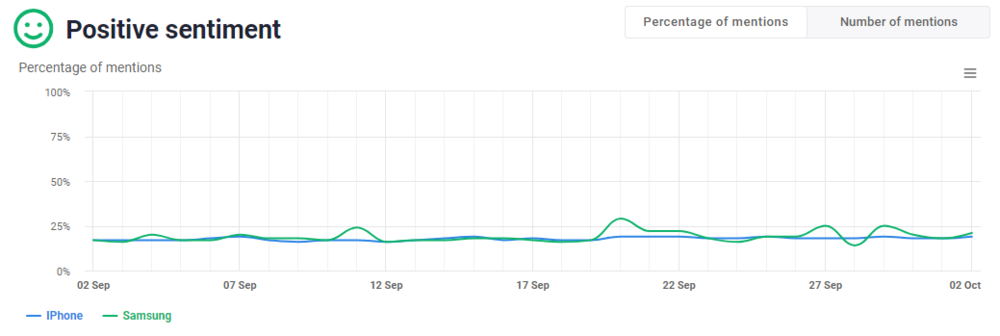
The metrics look similar for both brands, so let’s take a look at the important negative mentions of Samsung:
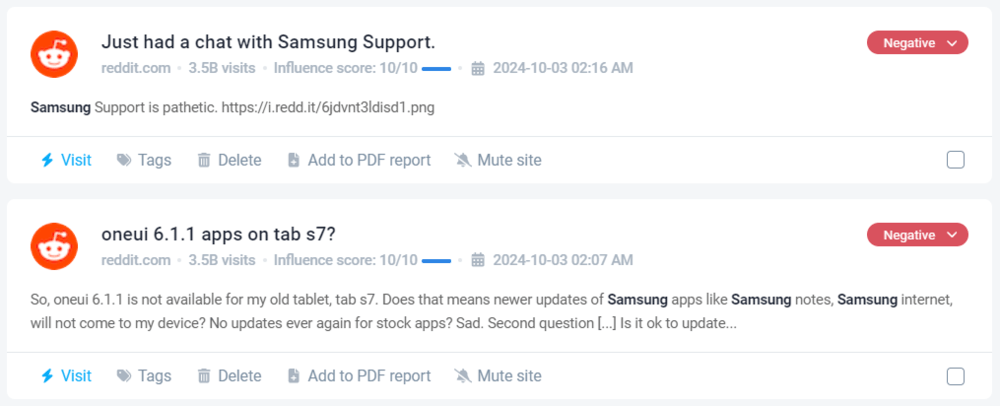
Share of Voice
Share of Voice measures how much of the Internet is dominated by either you or your competitors.
As you might guess, it is dominated by the iPhone. Also, if we consider only social media platforms:
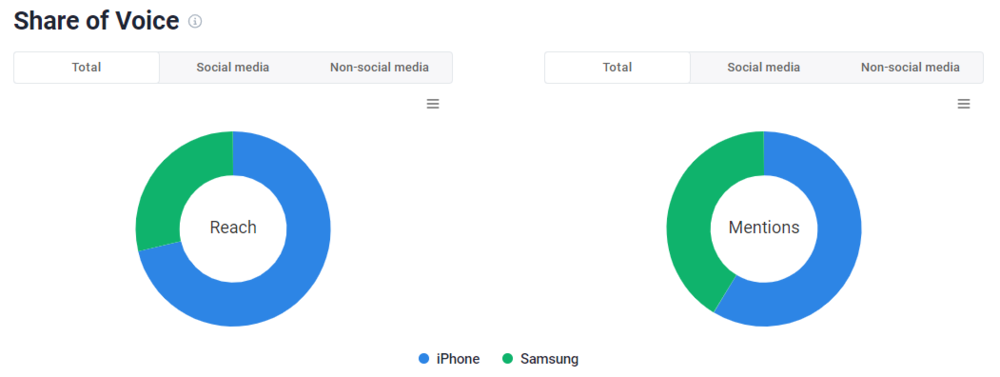
Presence Score
Looking at your competitor’s Presence Score, you can see how popular it is and, most importantly, whether it is more popular than you.


The iPhone’s Presence Score is 96, and Samsung’s is 89 – not that far apart, but at this point, the iPhone is a more recognizable brand.
Insights
By monitoring the consumer reviews of your competitors, you can gain insight into what to include in your products to make your competitors’ customers become yours.
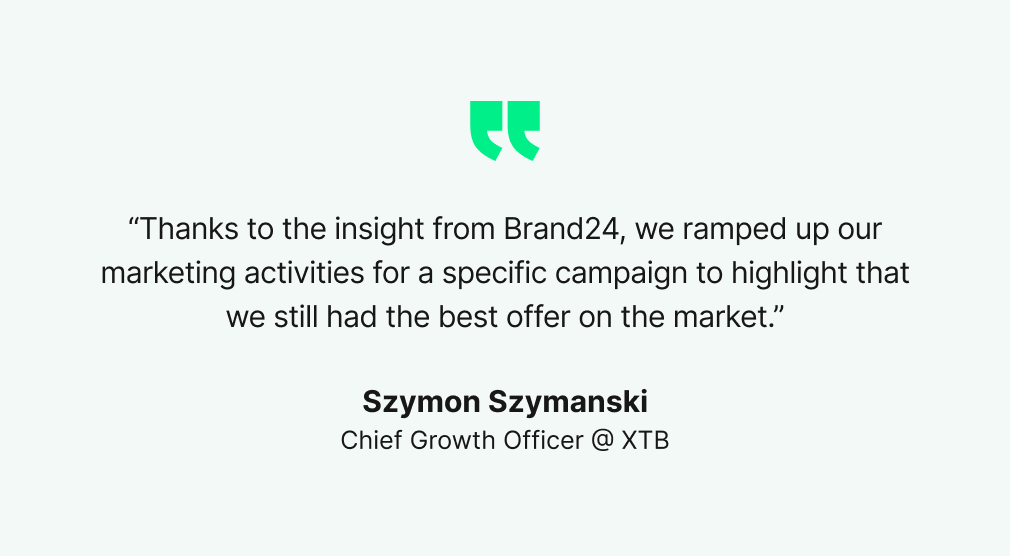
Discover our client’s success story — read the case study.
I wrote this prompt for Brand Assistant:
Summarize negative consumer reviews of [competitor’s name] to show me the gaps in the market
Let’s see what Samsung users are complaining about and how can iPhone make use of it:
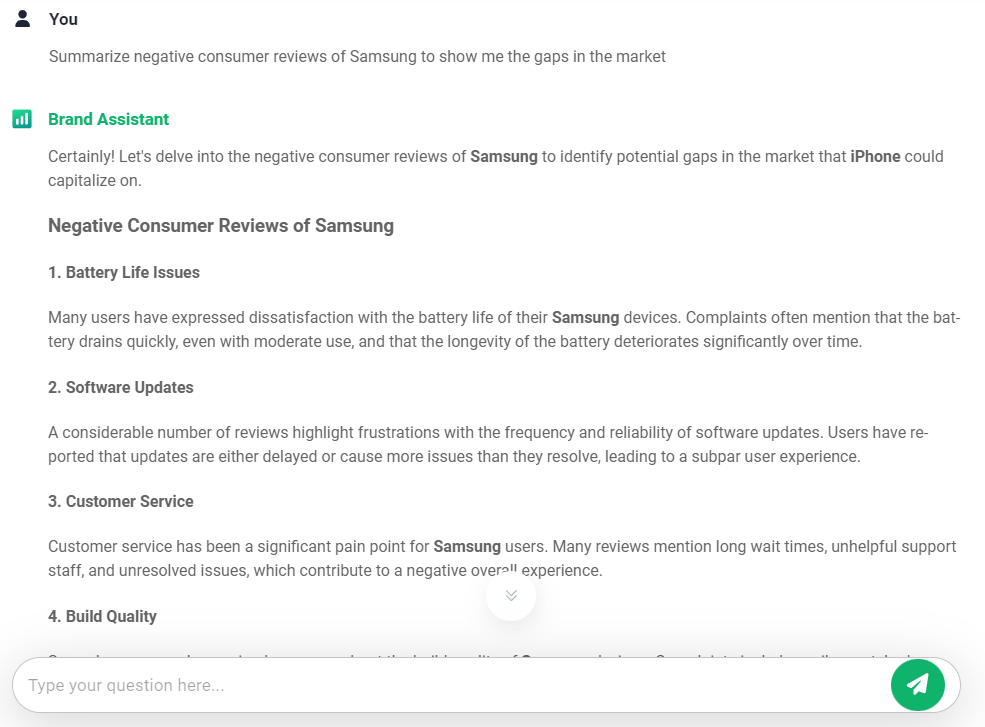
Comparison overview
A comparison overview shows how iPhone and Samsung perform in relation to each other in terms of different metrics:
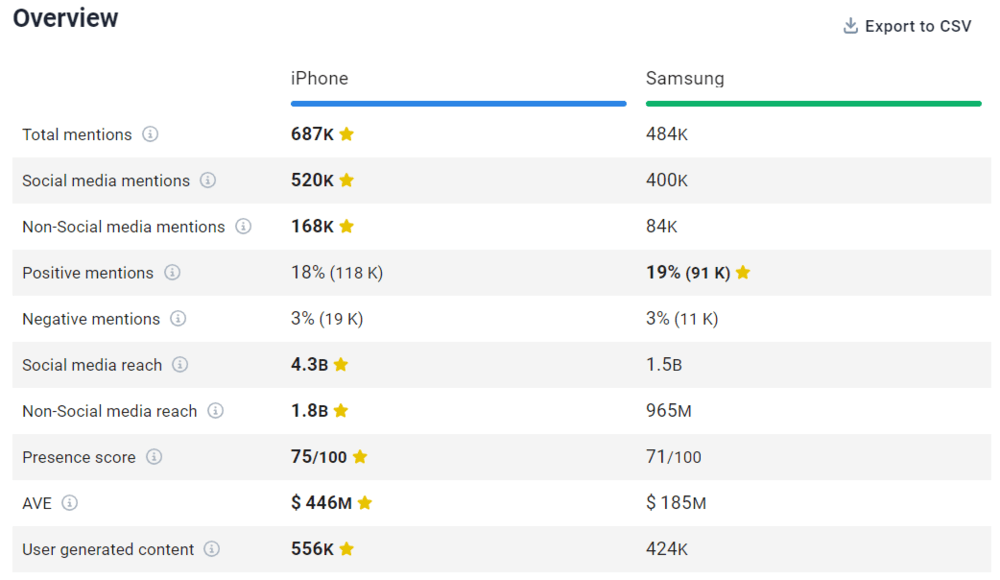
Based on this, the iPhone is clearly a cut above Samsung.
Start monitoring your competitors!
I’ve shown you how to monitor two brands – iPhone and its competitor, Samsung – but you can monitor and compare even more brands.
If you want to see real-world examples of social media monitoring in action, check out our article on Social Listening Examples to learn how brands track conversations, trends, and competitor activity.
Competitor Monitoring Tools vs Competitive Intelligence Tools
While competitor monitoring tools focus on tracking your rivals’ activities and performance metrics in real time, competitive intelligence tools provide a broader view of the market landscape, competitor strategies, and industry trends.
Together, they deliver immediate and strategic insights to refine your marketing strategies and gain a competitive edge.
| Aspect | Competitor Monitoring Tools | Competitive Intelligence Tools |
|---|---|---|
| Purpose | Track competitors’ activities and performance metrics across social media, websites, SEO, and PPC campaigns. | Collect, analyze, and interpret data on competitors, market research, audience behavior, and industry developments to guide strategic decisions. |
| Focus | Short-term insights and real-time tracking of competitors. | Long-term strategic insights, including market positioning & competitive benchmarking. |
| Data Types | Social media metrics, keyword rankings, content updates, and ad campaigns. | Same as above, plus market & industry news, consumer behavior, and pricing strategies. |
| Use Case | Helps marketing teams react quickly to competitor moves. | Supports executives and strategy teams in shaping business strategy and gaining a competitive edge. |
By combining both approaches, companies can monitor multiple competitors, uncover valuable insights, track competitor keywords, and make data-driven decisions that strengthen their market positioning and optimize their content strategy.
Here you can find a list of competitive intelligence tools my colleague tested in 2025: Top 10 Competitive Intelligence Tools to Use.
Of all the tools, choose the one that meets your requirements. Maybe it’s Brand24 – start a free trial now and see for yourself!



